Health Variations 3: Pathophysiology of Heart Failure Assignment
VerifiedAdded on 2022/10/02
|11
|2638
|3
Homework Assignment
AI Summary
This assignment analyzes a case study of a patient, Mrs. Brown, experiencing an acute exacerbation of systolic heart failure. The student addresses the patient's symptoms, including dyspnea, low SpO2, and low blood pressure, linking them to the pathophysiology of the condition. The assignment details the role of the nurse in assessing the patient and providing appropriate care, including oxygen therapy and effective communication strategies. It also discusses the medications prescribed, IV Furosemide and Glyceryl Trinitrate, explaining their mechanisms of action in managing heart failure. The student provides a comprehensive overview of the disease, its causes, and the importance of early diagnosis and patient education for better disease management. The assignment also references relevant literature to support the analysis.
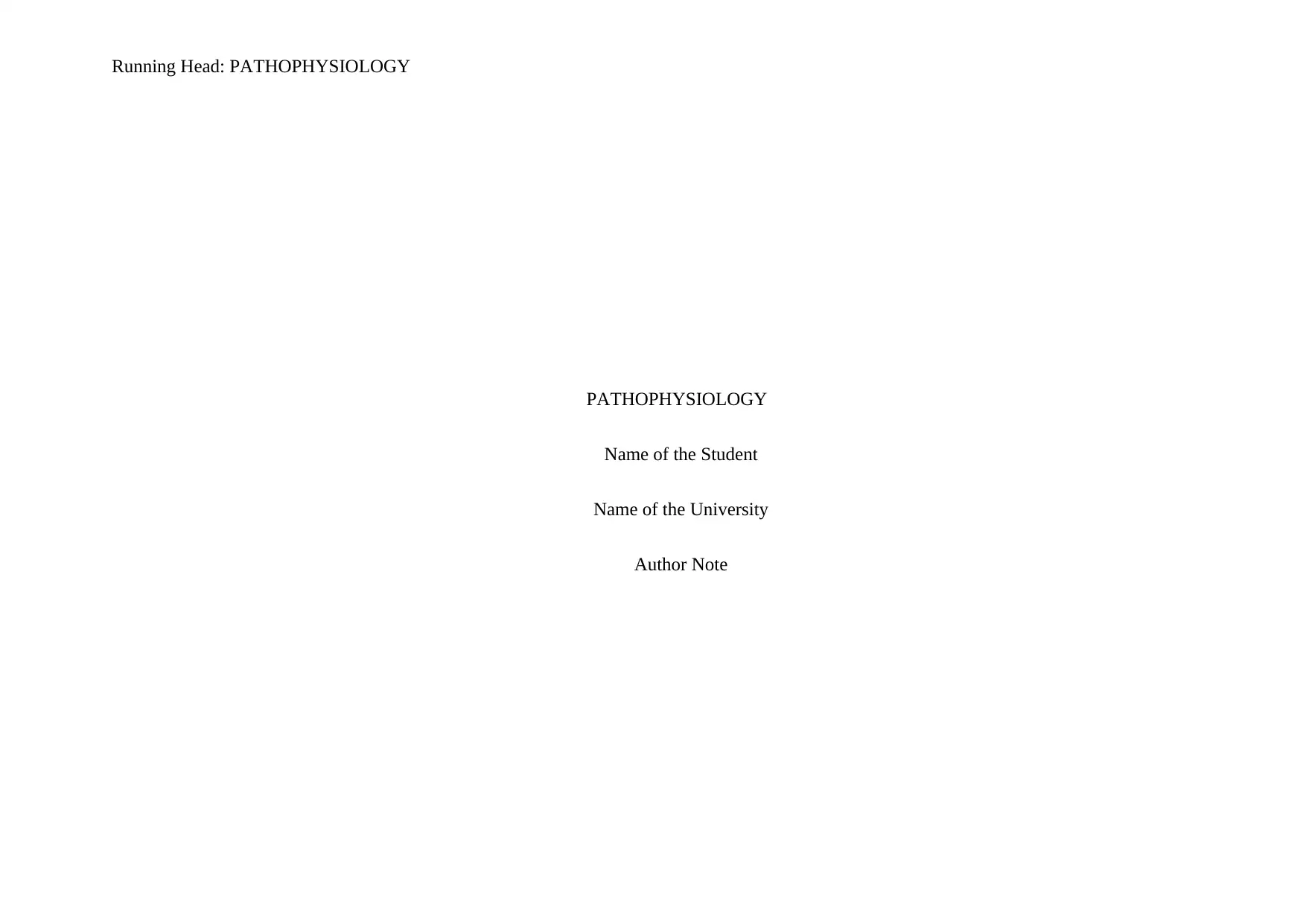
Running Head: PATHOPHYSIOLOGY
PATHOPHYSIOLOGY
Name of the Student
Name of the University
Author Note
PATHOPHYSIOLOGY
Name of the Student
Name of the University
Author Note
Paraphrase This Document
Need a fresh take? Get an instant paraphrase of this document with our AI Paraphraser
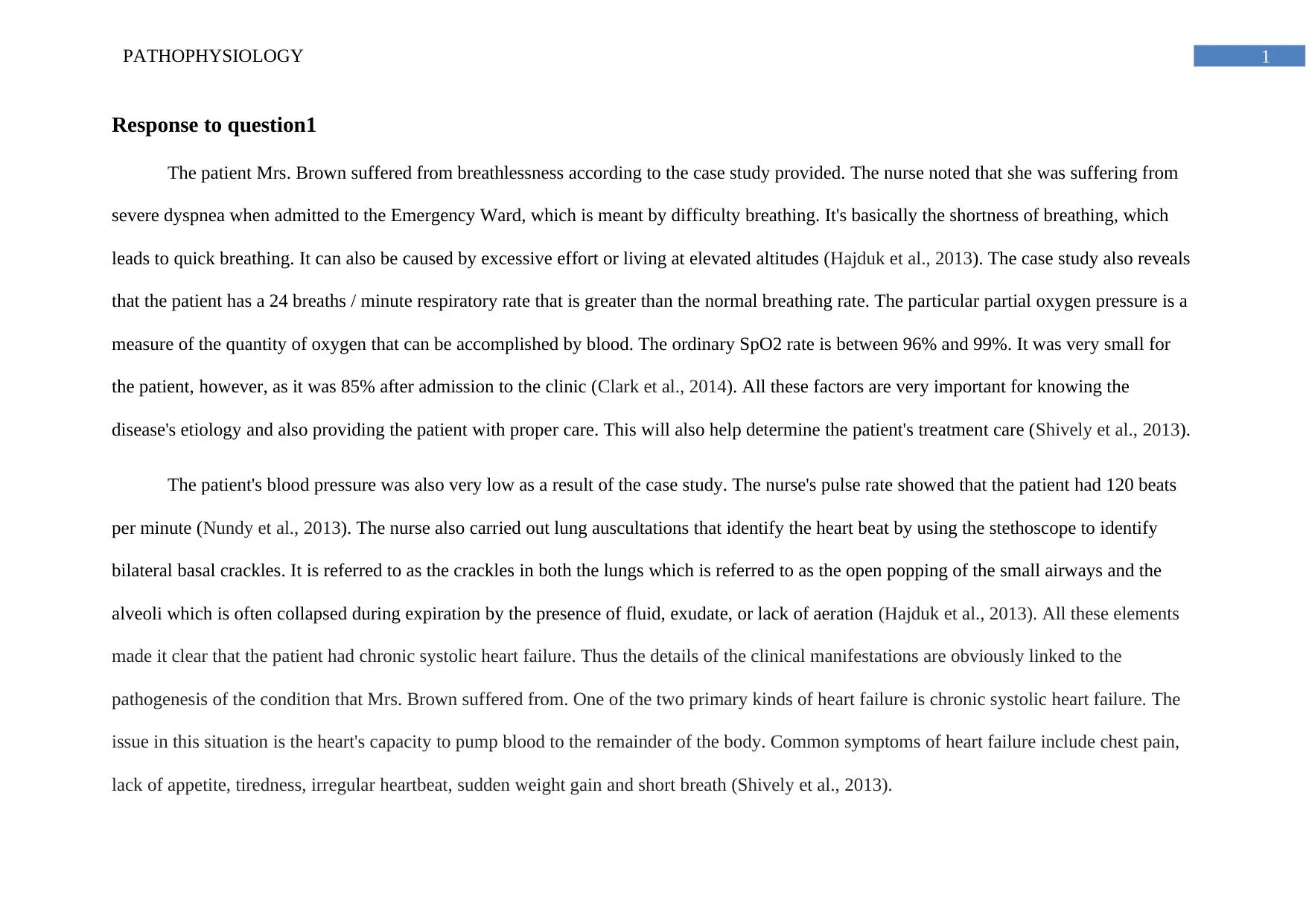
1PATHOPHYSIOLOGY
Response to question1
The patient Mrs. Brown suffered from breathlessness according to the case study provided. The nurse noted that she was suffering from
severe dyspnea when admitted to the Emergency Ward, which is meant by difficulty breathing. It's basically the shortness of breathing, which
leads to quick breathing. It can also be caused by excessive effort or living at elevated altitudes (Hajduk et al., 2013). The case study also reveals
that the patient has a 24 breaths / minute respiratory rate that is greater than the normal breathing rate. The particular partial oxygen pressure is a
measure of the quantity of oxygen that can be accomplished by blood. The ordinary SpO2 rate is between 96% and 99%. It was very small for
the patient, however, as it was 85% after admission to the clinic (Clark et al., 2014). All these factors are very important for knowing the
disease's etiology and also providing the patient with proper care. This will also help determine the patient's treatment care (Shively et al., 2013).
The patient's blood pressure was also very low as a result of the case study. The nurse's pulse rate showed that the patient had 120 beats
per minute (Nundy et al., 2013). The nurse also carried out lung auscultations that identify the heart beat by using the stethoscope to identify
bilateral basal crackles. It is referred to as the crackles in both the lungs which is referred to as the open popping of the small airways and the
alveoli which is often collapsed during expiration by the presence of fluid, exudate, or lack of aeration (Hajduk et al., 2013). All these elements
made it clear that the patient had chronic systolic heart failure. Thus the details of the clinical manifestations are obviously linked to the
pathogenesis of the condition that Mrs. Brown suffered from. One of the two primary kinds of heart failure is chronic systolic heart failure. The
issue in this situation is the heart's capacity to pump blood to the remainder of the body. Common symptoms of heart failure include chest pain,
lack of appetite, tiredness, irregular heartbeat, sudden weight gain and short breath (Shively et al., 2013).
Response to question1
The patient Mrs. Brown suffered from breathlessness according to the case study provided. The nurse noted that she was suffering from
severe dyspnea when admitted to the Emergency Ward, which is meant by difficulty breathing. It's basically the shortness of breathing, which
leads to quick breathing. It can also be caused by excessive effort or living at elevated altitudes (Hajduk et al., 2013). The case study also reveals
that the patient has a 24 breaths / minute respiratory rate that is greater than the normal breathing rate. The particular partial oxygen pressure is a
measure of the quantity of oxygen that can be accomplished by blood. The ordinary SpO2 rate is between 96% and 99%. It was very small for
the patient, however, as it was 85% after admission to the clinic (Clark et al., 2014). All these factors are very important for knowing the
disease's etiology and also providing the patient with proper care. This will also help determine the patient's treatment care (Shively et al., 2013).
The patient's blood pressure was also very low as a result of the case study. The nurse's pulse rate showed that the patient had 120 beats
per minute (Nundy et al., 2013). The nurse also carried out lung auscultations that identify the heart beat by using the stethoscope to identify
bilateral basal crackles. It is referred to as the crackles in both the lungs which is referred to as the open popping of the small airways and the
alveoli which is often collapsed during expiration by the presence of fluid, exudate, or lack of aeration (Hajduk et al., 2013). All these elements
made it clear that the patient had chronic systolic heart failure. Thus the details of the clinical manifestations are obviously linked to the
pathogenesis of the condition that Mrs. Brown suffered from. One of the two primary kinds of heart failure is chronic systolic heart failure. The
issue in this situation is the heart's capacity to pump blood to the remainder of the body. Common symptoms of heart failure include chest pain,
lack of appetite, tiredness, irregular heartbeat, sudden weight gain and short breath (Shively et al., 2013).
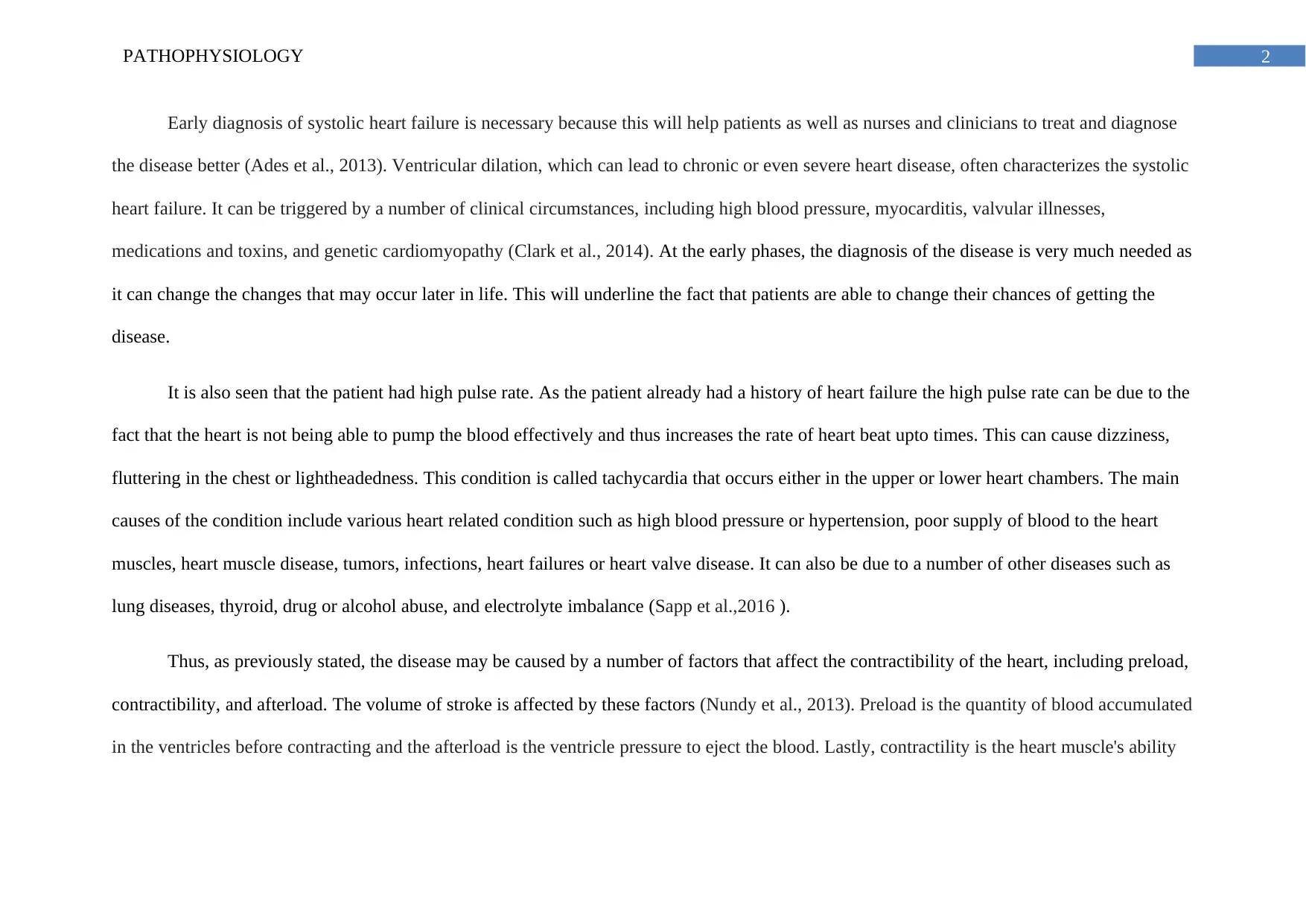
2PATHOPHYSIOLOGY
Early diagnosis of systolic heart failure is necessary because this will help patients as well as nurses and clinicians to treat and diagnose
the disease better (Ades et al., 2013). Ventricular dilation, which can lead to chronic or even severe heart disease, often characterizes the systolic
heart failure. It can be triggered by a number of clinical circumstances, including high blood pressure, myocarditis, valvular illnesses,
medications and toxins, and genetic cardiomyopathy (Clark et al., 2014). At the early phases, the diagnosis of the disease is very much needed as
it can change the changes that may occur later in life. This will underline the fact that patients are able to change their chances of getting the
disease.
It is also seen that the patient had high pulse rate. As the patient already had a history of heart failure the high pulse rate can be due to the
fact that the heart is not being able to pump the blood effectively and thus increases the rate of heart beat upto times. This can cause dizziness,
fluttering in the chest or lightheadedness. This condition is called tachycardia that occurs either in the upper or lower heart chambers. The main
causes of the condition include various heart related condition such as high blood pressure or hypertension, poor supply of blood to the heart
muscles, heart muscle disease, tumors, infections, heart failures or heart valve disease. It can also be due to a number of other diseases such as
lung diseases, thyroid, drug or alcohol abuse, and electrolyte imbalance (Sapp et al.,2016 ).
Thus, as previously stated, the disease may be caused by a number of factors that affect the contractibility of the heart, including preload,
contractibility, and afterload. The volume of stroke is affected by these factors (Nundy et al., 2013). Preload is the quantity of blood accumulated
in the ventricles before contracting and the afterload is the ventricle pressure to eject the blood. Lastly, contractility is the heart muscle's ability
Early diagnosis of systolic heart failure is necessary because this will help patients as well as nurses and clinicians to treat and diagnose
the disease better (Ades et al., 2013). Ventricular dilation, which can lead to chronic or even severe heart disease, often characterizes the systolic
heart failure. It can be triggered by a number of clinical circumstances, including high blood pressure, myocarditis, valvular illnesses,
medications and toxins, and genetic cardiomyopathy (Clark et al., 2014). At the early phases, the diagnosis of the disease is very much needed as
it can change the changes that may occur later in life. This will underline the fact that patients are able to change their chances of getting the
disease.
It is also seen that the patient had high pulse rate. As the patient already had a history of heart failure the high pulse rate can be due to the
fact that the heart is not being able to pump the blood effectively and thus increases the rate of heart beat upto times. This can cause dizziness,
fluttering in the chest or lightheadedness. This condition is called tachycardia that occurs either in the upper or lower heart chambers. The main
causes of the condition include various heart related condition such as high blood pressure or hypertension, poor supply of blood to the heart
muscles, heart muscle disease, tumors, infections, heart failures or heart valve disease. It can also be due to a number of other diseases such as
lung diseases, thyroid, drug or alcohol abuse, and electrolyte imbalance (Sapp et al.,2016 ).
Thus, as previously stated, the disease may be caused by a number of factors that affect the contractibility of the heart, including preload,
contractibility, and afterload. The volume of stroke is affected by these factors (Nundy et al., 2013). Preload is the quantity of blood accumulated
in the ventricles before contracting and the afterload is the ventricle pressure to eject the blood. Lastly, contractility is the heart muscle's ability
⊘ This is a preview!⊘
Do you want full access?
Subscribe today to unlock all pages.

Trusted by 1+ million students worldwide
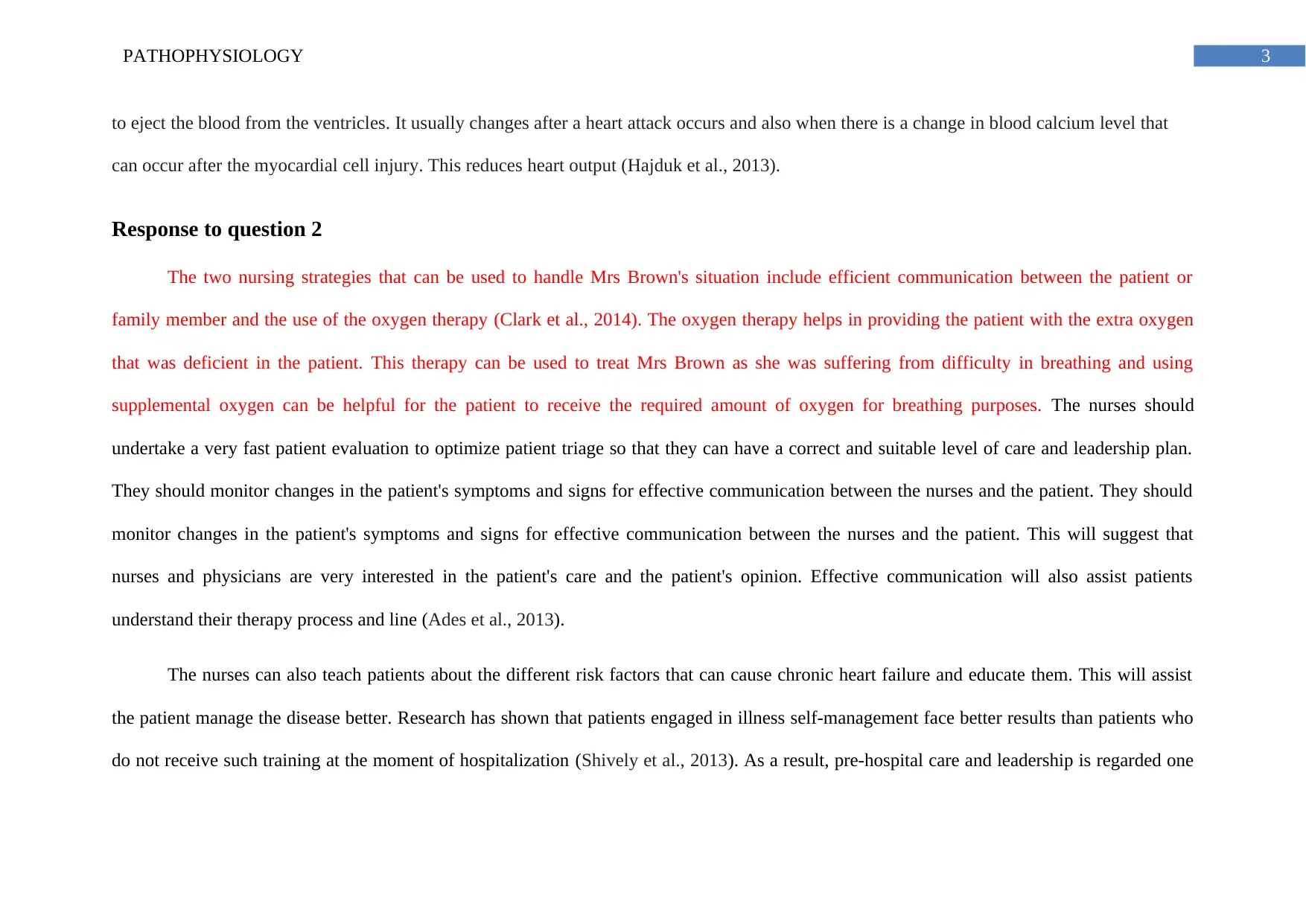
3PATHOPHYSIOLOGY
to eject the blood from the ventricles. It usually changes after a heart attack occurs and also when there is a change in blood calcium level that
can occur after the myocardial cell injury. This reduces heart output (Hajduk et al., 2013).
Response to question 2
The two nursing strategies that can be used to handle Mrs Brown's situation include efficient communication between the patient or
family member and the use of the oxygen therapy (Clark et al., 2014). The oxygen therapy helps in providing the patient with the extra oxygen
that was deficient in the patient. This therapy can be used to treat Mrs Brown as she was suffering from difficulty in breathing and using
supplemental oxygen can be helpful for the patient to receive the required amount of oxygen for breathing purposes. The nurses should
undertake a very fast patient evaluation to optimize patient triage so that they can have a correct and suitable level of care and leadership plan.
They should monitor changes in the patient's symptoms and signs for effective communication between the nurses and the patient. They should
monitor changes in the patient's symptoms and signs for effective communication between the nurses and the patient. This will suggest that
nurses and physicians are very interested in the patient's care and the patient's opinion. Effective communication will also assist patients
understand their therapy process and line (Ades et al., 2013).
The nurses can also teach patients about the different risk factors that can cause chronic heart failure and educate them. This will assist
the patient manage the disease better. Research has shown that patients engaged in illness self-management face better results than patients who
do not receive such training at the moment of hospitalization (Shively et al., 2013). As a result, pre-hospital care and leadership is regarded one
to eject the blood from the ventricles. It usually changes after a heart attack occurs and also when there is a change in blood calcium level that
can occur after the myocardial cell injury. This reduces heart output (Hajduk et al., 2013).
Response to question 2
The two nursing strategies that can be used to handle Mrs Brown's situation include efficient communication between the patient or
family member and the use of the oxygen therapy (Clark et al., 2014). The oxygen therapy helps in providing the patient with the extra oxygen
that was deficient in the patient. This therapy can be used to treat Mrs Brown as she was suffering from difficulty in breathing and using
supplemental oxygen can be helpful for the patient to receive the required amount of oxygen for breathing purposes. The nurses should
undertake a very fast patient evaluation to optimize patient triage so that they can have a correct and suitable level of care and leadership plan.
They should monitor changes in the patient's symptoms and signs for effective communication between the nurses and the patient. They should
monitor changes in the patient's symptoms and signs for effective communication between the nurses and the patient. This will suggest that
nurses and physicians are very interested in the patient's care and the patient's opinion. Effective communication will also assist patients
understand their therapy process and line (Ades et al., 2013).
The nurses can also teach patients about the different risk factors that can cause chronic heart failure and educate them. This will assist
the patient manage the disease better. Research has shown that patients engaged in illness self-management face better results than patients who
do not receive such training at the moment of hospitalization (Shively et al., 2013). As a result, pre-hospital care and leadership is regarded one
Paraphrase This Document
Need a fresh take? Get an instant paraphrase of this document with our AI Paraphraser
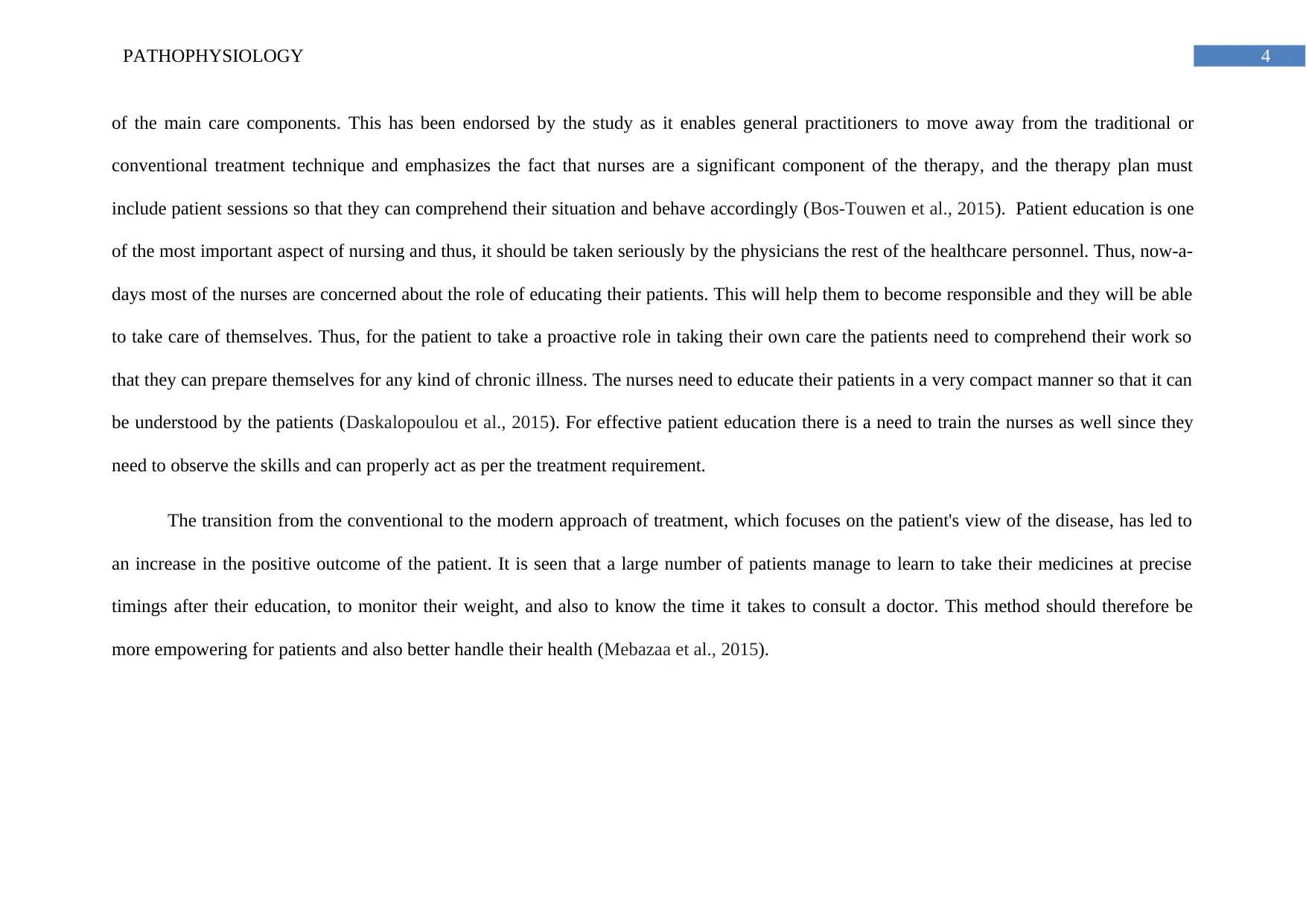
4PATHOPHYSIOLOGY
of the main care components. This has been endorsed by the study as it enables general practitioners to move away from the traditional or
conventional treatment technique and emphasizes the fact that nurses are a significant component of the therapy, and the therapy plan must
include patient sessions so that they can comprehend their situation and behave accordingly (Bos-Touwen et al., 2015). Patient education is one
of the most important aspect of nursing and thus, it should be taken seriously by the physicians the rest of the healthcare personnel. Thus, now-a-
days most of the nurses are concerned about the role of educating their patients. This will help them to become responsible and they will be able
to take care of themselves. Thus, for the patient to take a proactive role in taking their own care the patients need to comprehend their work so
that they can prepare themselves for any kind of chronic illness. The nurses need to educate their patients in a very compact manner so that it can
be understood by the patients (Daskalopoulou et al., 2015). For effective patient education there is a need to train the nurses as well since they
need to observe the skills and can properly act as per the treatment requirement.
The transition from the conventional to the modern approach of treatment, which focuses on the patient's view of the disease, has led to
an increase in the positive outcome of the patient. It is seen that a large number of patients manage to learn to take their medicines at precise
timings after their education, to monitor their weight, and also to know the time it takes to consult a doctor. This method should therefore be
more empowering for patients and also better handle their health (Mebazaa et al., 2015).
of the main care components. This has been endorsed by the study as it enables general practitioners to move away from the traditional or
conventional treatment technique and emphasizes the fact that nurses are a significant component of the therapy, and the therapy plan must
include patient sessions so that they can comprehend their situation and behave accordingly (Bos-Touwen et al., 2015). Patient education is one
of the most important aspect of nursing and thus, it should be taken seriously by the physicians the rest of the healthcare personnel. Thus, now-a-
days most of the nurses are concerned about the role of educating their patients. This will help them to become responsible and they will be able
to take care of themselves. Thus, for the patient to take a proactive role in taking their own care the patients need to comprehend their work so
that they can prepare themselves for any kind of chronic illness. The nurses need to educate their patients in a very compact manner so that it can
be understood by the patients (Daskalopoulou et al., 2015). For effective patient education there is a need to train the nurses as well since they
need to observe the skills and can properly act as per the treatment requirement.
The transition from the conventional to the modern approach of treatment, which focuses on the patient's view of the disease, has led to
an increase in the positive outcome of the patient. It is seen that a large number of patients manage to learn to take their medicines at precise
timings after their education, to monitor their weight, and also to know the time it takes to consult a doctor. This method should therefore be
more empowering for patients and also better handle their health (Mebazaa et al., 2015).
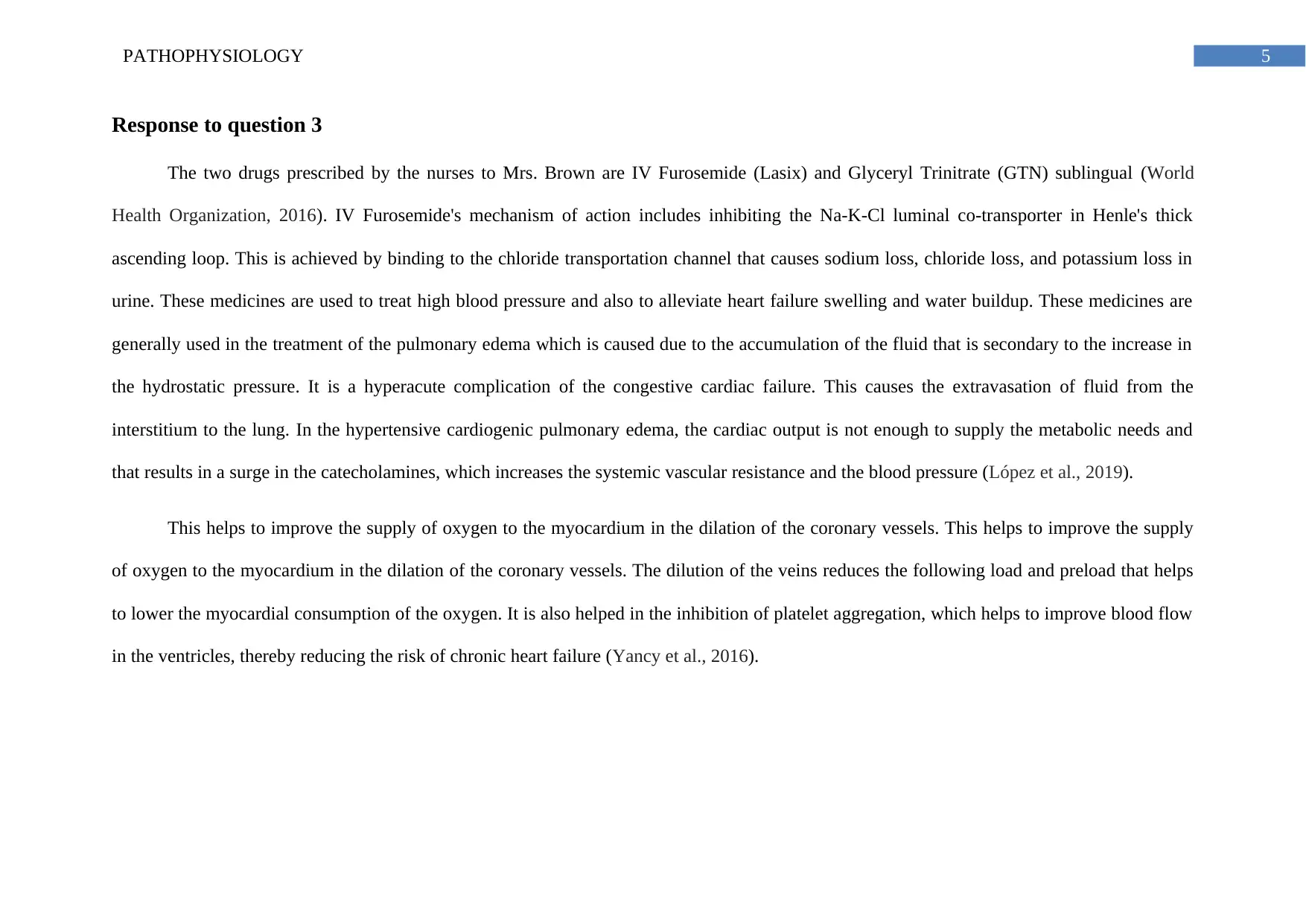
5PATHOPHYSIOLOGY
Response to question 3
The two drugs prescribed by the nurses to Mrs. Brown are IV Furosemide (Lasix) and Glyceryl Trinitrate (GTN) sublingual (World
Health Organization, 2016). IV Furosemide's mechanism of action includes inhibiting the Na-K-Cl luminal co-transporter in Henle's thick
ascending loop. This is achieved by binding to the chloride transportation channel that causes sodium loss, chloride loss, and potassium loss in
urine. These medicines are used to treat high blood pressure and also to alleviate heart failure swelling and water buildup. These medicines are
generally used in the treatment of the pulmonary edema which is caused due to the accumulation of the fluid that is secondary to the increase in
the hydrostatic pressure. It is a hyperacute complication of the congestive cardiac failure. This causes the extravasation of fluid from the
interstitium to the lung. In the hypertensive cardiogenic pulmonary edema, the cardiac output is not enough to supply the metabolic needs and
that results in a surge in the catecholamines, which increases the systemic vascular resistance and the blood pressure (López et al., 2019).
This helps to improve the supply of oxygen to the myocardium in the dilation of the coronary vessels. This helps to improve the supply
of oxygen to the myocardium in the dilation of the coronary vessels. The dilution of the veins reduces the following load and preload that helps
to lower the myocardial consumption of the oxygen. It is also helped in the inhibition of platelet aggregation, which helps to improve blood flow
in the ventricles, thereby reducing the risk of chronic heart failure (Yancy et al., 2016).
Response to question 3
The two drugs prescribed by the nurses to Mrs. Brown are IV Furosemide (Lasix) and Glyceryl Trinitrate (GTN) sublingual (World
Health Organization, 2016). IV Furosemide's mechanism of action includes inhibiting the Na-K-Cl luminal co-transporter in Henle's thick
ascending loop. This is achieved by binding to the chloride transportation channel that causes sodium loss, chloride loss, and potassium loss in
urine. These medicines are used to treat high blood pressure and also to alleviate heart failure swelling and water buildup. These medicines are
generally used in the treatment of the pulmonary edema which is caused due to the accumulation of the fluid that is secondary to the increase in
the hydrostatic pressure. It is a hyperacute complication of the congestive cardiac failure. This causes the extravasation of fluid from the
interstitium to the lung. In the hypertensive cardiogenic pulmonary edema, the cardiac output is not enough to supply the metabolic needs and
that results in a surge in the catecholamines, which increases the systemic vascular resistance and the blood pressure (López et al., 2019).
This helps to improve the supply of oxygen to the myocardium in the dilation of the coronary vessels. This helps to improve the supply
of oxygen to the myocardium in the dilation of the coronary vessels. The dilution of the veins reduces the following load and preload that helps
to lower the myocardial consumption of the oxygen. It is also helped in the inhibition of platelet aggregation, which helps to improve blood flow
in the ventricles, thereby reducing the risk of chronic heart failure (Yancy et al., 2016).
⊘ This is a preview!⊘
Do you want full access?
Subscribe today to unlock all pages.

Trusted by 1+ million students worldwide
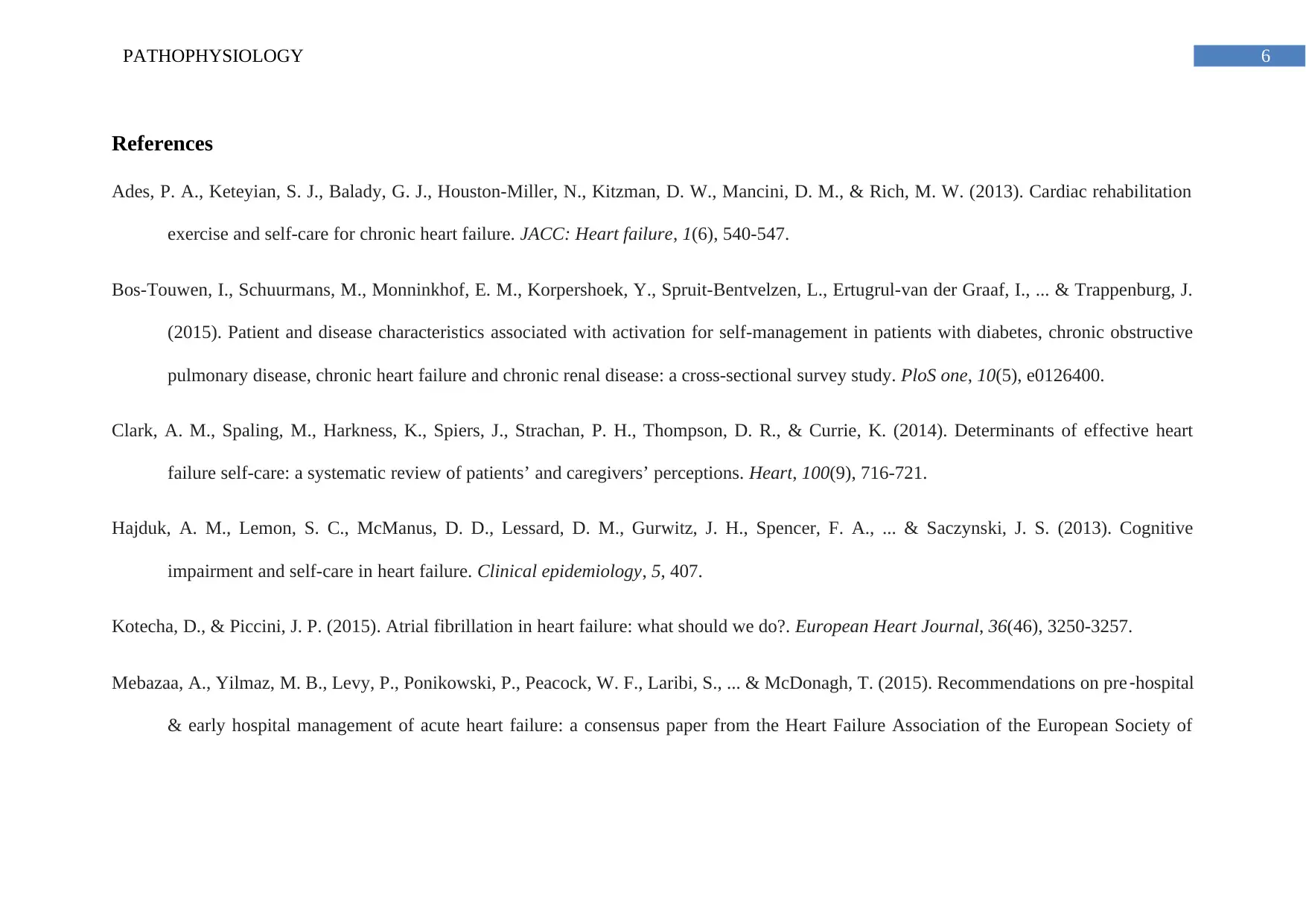
6PATHOPHYSIOLOGY
References
Ades, P. A., Keteyian, S. J., Balady, G. J., Houston-Miller, N., Kitzman, D. W., Mancini, D. M., & Rich, M. W. (2013). Cardiac rehabilitation
exercise and self-care for chronic heart failure. JACC: Heart failure, 1(6), 540-547.
Bos-Touwen, I., Schuurmans, M., Monninkhof, E. M., Korpershoek, Y., Spruit-Bentvelzen, L., Ertugrul-van der Graaf, I., ... & Trappenburg, J.
(2015). Patient and disease characteristics associated with activation for self-management in patients with diabetes, chronic obstructive
pulmonary disease, chronic heart failure and chronic renal disease: a cross-sectional survey study. PloS one, 10(5), e0126400.
Clark, A. M., Spaling, M., Harkness, K., Spiers, J., Strachan, P. H., Thompson, D. R., & Currie, K. (2014). Determinants of effective heart
failure self-care: a systematic review of patients’ and caregivers’ perceptions. Heart, 100(9), 716-721.
Hajduk, A. M., Lemon, S. C., McManus, D. D., Lessard, D. M., Gurwitz, J. H., Spencer, F. A., ... & Saczynski, J. S. (2013). Cognitive
impairment and self-care in heart failure. Clinical epidemiology, 5, 407.
Kotecha, D., & Piccini, J. P. (2015). Atrial fibrillation in heart failure: what should we do?. European Heart Journal, 36(46), 3250-3257.
Mebazaa, A., Yilmaz, M. B., Levy, P., Ponikowski, P., Peacock, W. F., Laribi, S., ... & McDonagh, T. (2015). Recommendations on pre ‐hospital
& early hospital management of acute heart failure: a consensus paper from the Heart Failure Association of the European Society of
References
Ades, P. A., Keteyian, S. J., Balady, G. J., Houston-Miller, N., Kitzman, D. W., Mancini, D. M., & Rich, M. W. (2013). Cardiac rehabilitation
exercise and self-care for chronic heart failure. JACC: Heart failure, 1(6), 540-547.
Bos-Touwen, I., Schuurmans, M., Monninkhof, E. M., Korpershoek, Y., Spruit-Bentvelzen, L., Ertugrul-van der Graaf, I., ... & Trappenburg, J.
(2015). Patient and disease characteristics associated with activation for self-management in patients with diabetes, chronic obstructive
pulmonary disease, chronic heart failure and chronic renal disease: a cross-sectional survey study. PloS one, 10(5), e0126400.
Clark, A. M., Spaling, M., Harkness, K., Spiers, J., Strachan, P. H., Thompson, D. R., & Currie, K. (2014). Determinants of effective heart
failure self-care: a systematic review of patients’ and caregivers’ perceptions. Heart, 100(9), 716-721.
Hajduk, A. M., Lemon, S. C., McManus, D. D., Lessard, D. M., Gurwitz, J. H., Spencer, F. A., ... & Saczynski, J. S. (2013). Cognitive
impairment and self-care in heart failure. Clinical epidemiology, 5, 407.
Kotecha, D., & Piccini, J. P. (2015). Atrial fibrillation in heart failure: what should we do?. European Heart Journal, 36(46), 3250-3257.
Mebazaa, A., Yilmaz, M. B., Levy, P., Ponikowski, P., Peacock, W. F., Laribi, S., ... & McDonagh, T. (2015). Recommendations on pre ‐hospital
& early hospital management of acute heart failure: a consensus paper from the Heart Failure Association of the European Society of
Paraphrase This Document
Need a fresh take? Get an instant paraphrase of this document with our AI Paraphraser
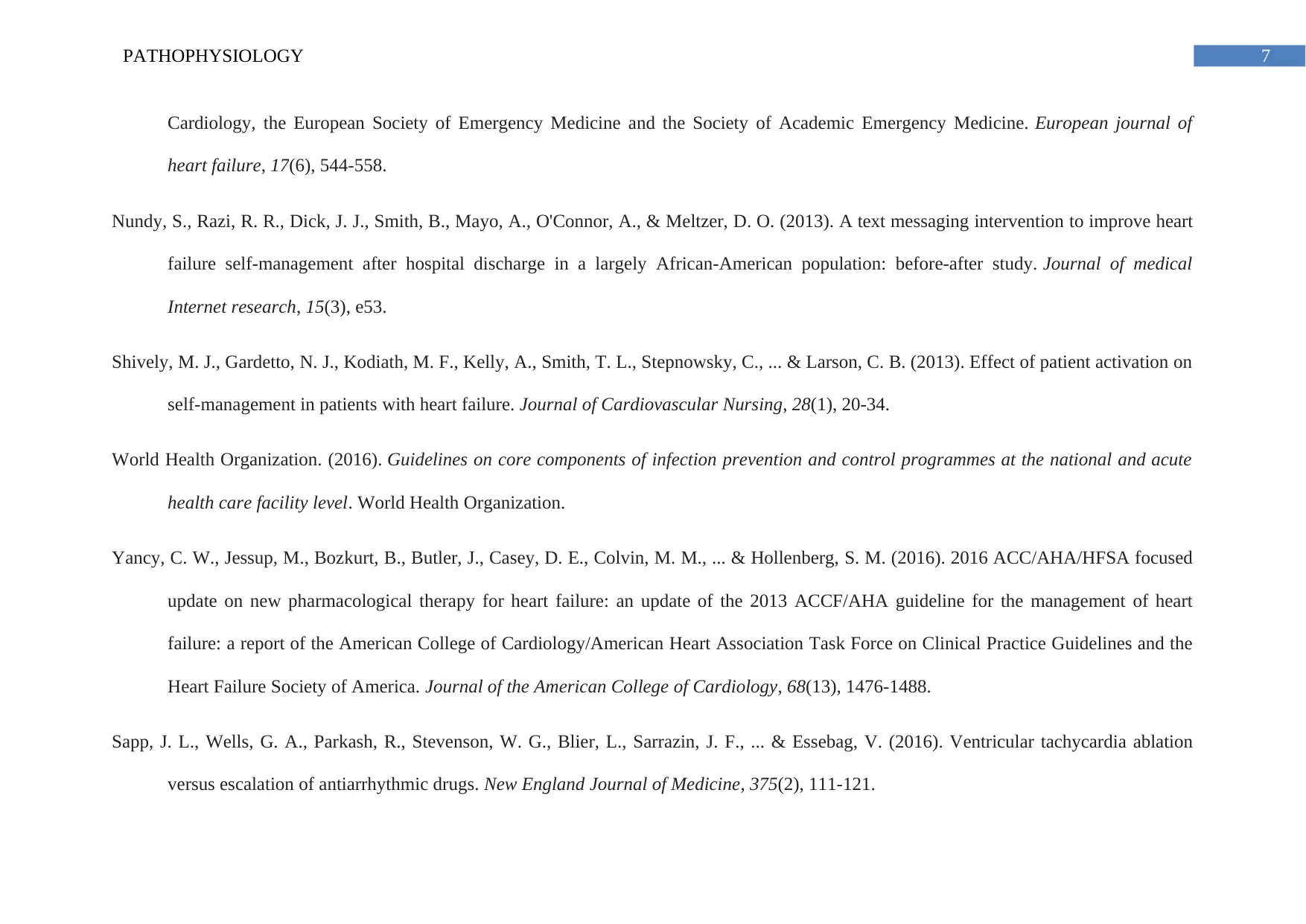
7PATHOPHYSIOLOGY
Cardiology, the European Society of Emergency Medicine and the Society of Academic Emergency Medicine. European journal of
heart failure, 17(6), 544-558.
Nundy, S., Razi, R. R., Dick, J. J., Smith, B., Mayo, A., O'Connor, A., & Meltzer, D. O. (2013). A text messaging intervention to improve heart
failure self-management after hospital discharge in a largely African-American population: before-after study. Journal of medical
Internet research, 15(3), e53.
Shively, M. J., Gardetto, N. J., Kodiath, M. F., Kelly, A., Smith, T. L., Stepnowsky, C., ... & Larson, C. B. (2013). Effect of patient activation on
self-management in patients with heart failure. Journal of Cardiovascular Nursing, 28(1), 20-34.
World Health Organization. (2016). Guidelines on core components of infection prevention and control programmes at the national and acute
health care facility level. World Health Organization.
Yancy, C. W., Jessup, M., Bozkurt, B., Butler, J., Casey, D. E., Colvin, M. M., ... & Hollenberg, S. M. (2016). 2016 ACC/AHA/HFSA focused
update on new pharmacological therapy for heart failure: an update of the 2013 ACCF/AHA guideline for the management of heart
failure: a report of the American College of Cardiology/American Heart Association Task Force on Clinical Practice Guidelines and the
Heart Failure Society of America. Journal of the American College of Cardiology, 68(13), 1476-1488.
Sapp, J. L., Wells, G. A., Parkash, R., Stevenson, W. G., Blier, L., Sarrazin, J. F., ... & Essebag, V. (2016). Ventricular tachycardia ablation
versus escalation of antiarrhythmic drugs. New England Journal of Medicine, 375(2), 111-121.
Cardiology, the European Society of Emergency Medicine and the Society of Academic Emergency Medicine. European journal of
heart failure, 17(6), 544-558.
Nundy, S., Razi, R. R., Dick, J. J., Smith, B., Mayo, A., O'Connor, A., & Meltzer, D. O. (2013). A text messaging intervention to improve heart
failure self-management after hospital discharge in a largely African-American population: before-after study. Journal of medical
Internet research, 15(3), e53.
Shively, M. J., Gardetto, N. J., Kodiath, M. F., Kelly, A., Smith, T. L., Stepnowsky, C., ... & Larson, C. B. (2013). Effect of patient activation on
self-management in patients with heart failure. Journal of Cardiovascular Nursing, 28(1), 20-34.
World Health Organization. (2016). Guidelines on core components of infection prevention and control programmes at the national and acute
health care facility level. World Health Organization.
Yancy, C. W., Jessup, M., Bozkurt, B., Butler, J., Casey, D. E., Colvin, M. M., ... & Hollenberg, S. M. (2016). 2016 ACC/AHA/HFSA focused
update on new pharmacological therapy for heart failure: an update of the 2013 ACCF/AHA guideline for the management of heart
failure: a report of the American College of Cardiology/American Heart Association Task Force on Clinical Practice Guidelines and the
Heart Failure Society of America. Journal of the American College of Cardiology, 68(13), 1476-1488.
Sapp, J. L., Wells, G. A., Parkash, R., Stevenson, W. G., Blier, L., Sarrazin, J. F., ... & Essebag, V. (2016). Ventricular tachycardia ablation
versus escalation of antiarrhythmic drugs. New England Journal of Medicine, 375(2), 111-121.
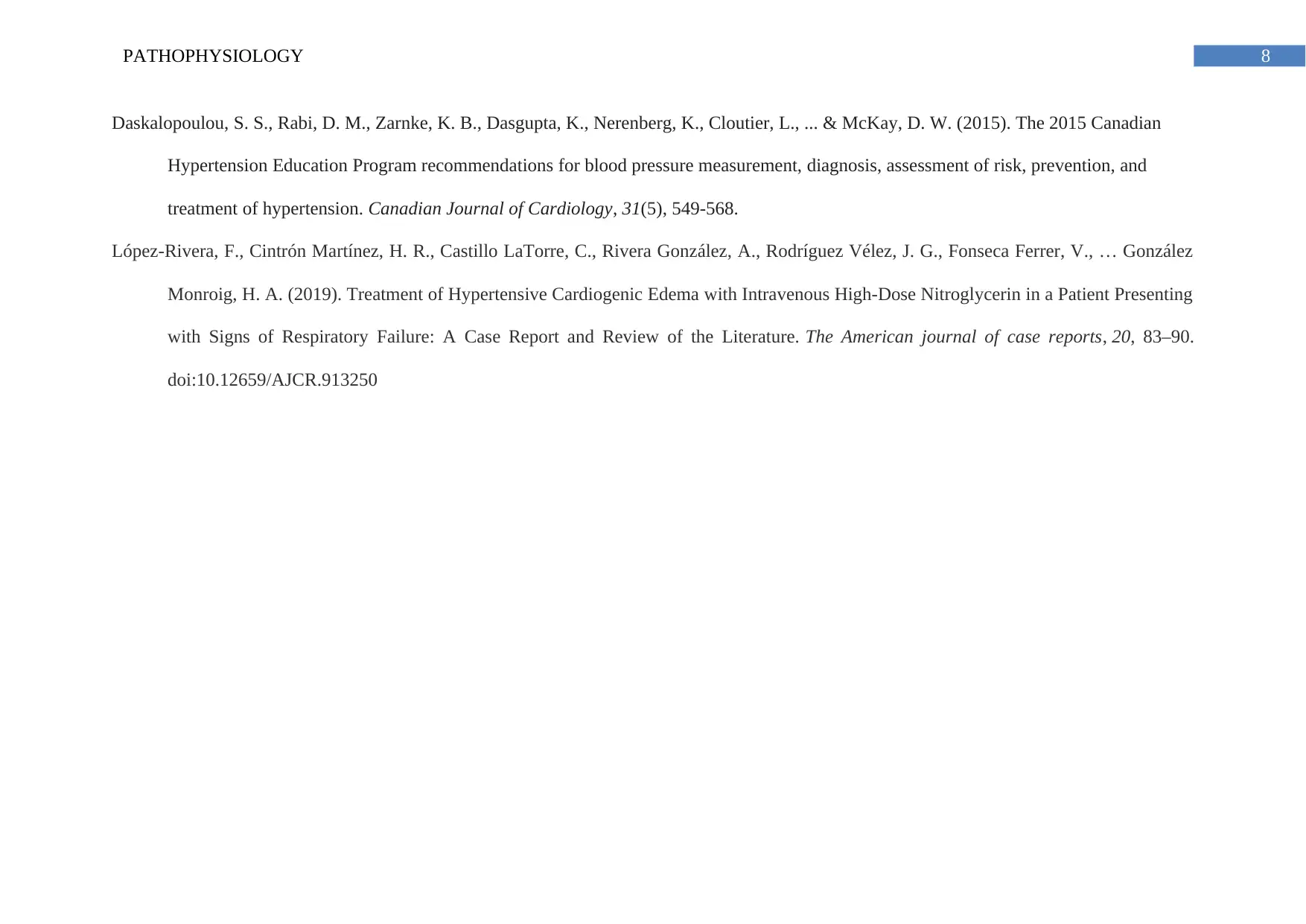
8PATHOPHYSIOLOGY
Daskalopoulou, S. S., Rabi, D. M., Zarnke, K. B., Dasgupta, K., Nerenberg, K., Cloutier, L., ... & McKay, D. W. (2015). The 2015 Canadian
Hypertension Education Program recommendations for blood pressure measurement, diagnosis, assessment of risk, prevention, and
treatment of hypertension. Canadian Journal of Cardiology, 31(5), 549-568.
López-Rivera, F., Cintrón Martínez, H. R., Castillo LaTorre, C., Rivera González, A., Rodríguez Vélez, J. G., Fonseca Ferrer, V., … González
Monroig, H. A. (2019). Treatment of Hypertensive Cardiogenic Edema with Intravenous High-Dose Nitroglycerin in a Patient Presenting
with Signs of Respiratory Failure: A Case Report and Review of the Literature. The American journal of case reports, 20, 83–90.
doi:10.12659/AJCR.913250
Daskalopoulou, S. S., Rabi, D. M., Zarnke, K. B., Dasgupta, K., Nerenberg, K., Cloutier, L., ... & McKay, D. W. (2015). The 2015 Canadian
Hypertension Education Program recommendations for blood pressure measurement, diagnosis, assessment of risk, prevention, and
treatment of hypertension. Canadian Journal of Cardiology, 31(5), 549-568.
López-Rivera, F., Cintrón Martínez, H. R., Castillo LaTorre, C., Rivera González, A., Rodríguez Vélez, J. G., Fonseca Ferrer, V., … González
Monroig, H. A. (2019). Treatment of Hypertensive Cardiogenic Edema with Intravenous High-Dose Nitroglycerin in a Patient Presenting
with Signs of Respiratory Failure: A Case Report and Review of the Literature. The American journal of case reports, 20, 83–90.
doi:10.12659/AJCR.913250
⊘ This is a preview!⊘
Do you want full access?
Subscribe today to unlock all pages.

Trusted by 1+ million students worldwide

9PATHOPHYSIOLOGY
Appendix
Concept Map
Appendix
Concept Map
Paraphrase This Document
Need a fresh take? Get an instant paraphrase of this document with our AI Paraphraser
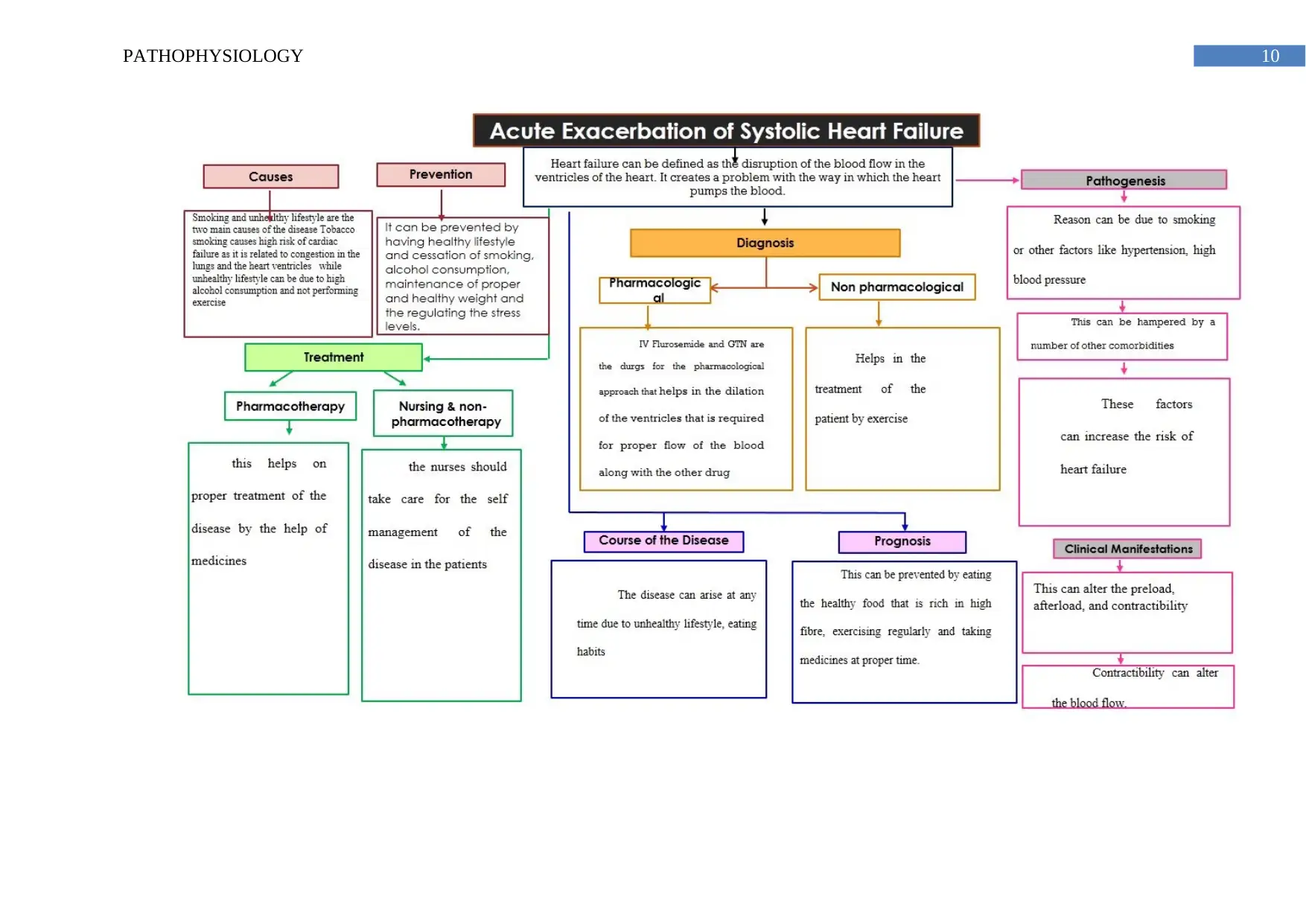
10PATHOPHYSIOLOGY
1 out of 11
Related Documents
Your All-in-One AI-Powered Toolkit for Academic Success.
+13062052269
info@desklib.com
Available 24*7 on WhatsApp / Email
![[object Object]](/_next/static/media/star-bottom.7253800d.svg)
Unlock your academic potential
Copyright © 2020–2025 A2Z Services. All Rights Reserved. Developed and managed by ZUCOL.





